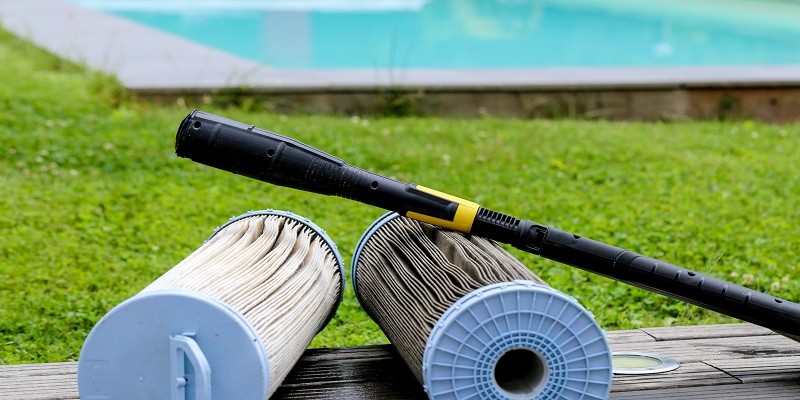Last Updated on October 17, 2023
To clean a pool filter, remove the filter cartridge and rinse it with water to remove any debris. Then, soak the cartridge in a filter cleaner solution and rinse it again before reinstalling.
Proper maintenance of your pool filter is essential for keeping your pool clean and clear of impurities. Neglecting to clean your pool filter regularly can lead to reduced filtration efficiency and the growth of harmful bacteria. By following these simple steps, you can ensure that your pool filter operates at its best and provides optimal water quality for a refreshing and enjoyable swimming experience.

Credit: www.swimmingpoolsteve.com
Cleaning A Pool Filter: A Step-By-Step Guide
A clean and properly functioning pool filter is crucial for maintaining crystal clear water in your pool. Regular maintenance of your pool filter not only ensures your water stays clean and safe, but also extends the lifespan of your filter.
In this step-by-step guide, we will walk you through the process of cleaning a pool filter to help you keep your pool water sparkling all season long.
Why Regular Maintenance Is Important:
Regular maintenance of your pool filter is essential for several reasons:
- Efficient filtration: A clean filter allows for optimal water circulation and filtration, ensuring that debris, dirt, and contaminants are effectively removed from the water.
- Prevents clogging: Over time, debris and particles can accumulate in the filter, leading to clogging and reduced water flow. Regular cleaning prevents this buildup and ensures efficient operation.
- Cost savings: A properly maintained filter requires less energy to operate, which can result in cost savings on your energy bills.
- Prolongs filter lifespan: Regular cleaning prevents excessive strain on the filter components, reducing the risk of damage and extending its overall lifespan.
- Improved water clarity: By keeping your filter clean, you can enjoy clear, sparkling water that is inviting and safe for swimming.
Now that you understand the importance of regular maintenance, let’s dive into the step-by-step guide on how to clean a pool filter.
Step 1: Turn Off The Pool Pump
Before you begin cleaning your pool filter, ensure that the pool pump is switched off. This will prevent any accidents or water flow issues during the cleaning process.
Step 2: Release Pressure And Drain Water
Relieve the pressure in the filter system by turning the air relief valve or opening the pressure release valve. Next, drain any excess water from the filter tank by opening the drain plug or valve.
Step 3: Remove The Filter Element
Depending on the type of pool filter you have (cartridge, sand, or de), carefully remove the filter element from the tank. Refer to the manufacturer’s instructions for specific guidance on removing the filter element.
Step 4: Rinse The Filter Element
Using a garden hose, thoroughly rinse the filter element to remove any loose debris and dirt. Pay close attention to all sides of the filter to ensure a thorough rinse.
Step 5: Soak The Filter Element (For Cartridge Filters)
If you have a cartridge filter, it’s recommended to soak the filter element in a filter cleaning solution. Follow the product instructions for the correct duration of the soak. This will help remove any remaining oils or contaminants from the cartridge.
Step 6: Inspect The Filter Element
Carefully inspect the filter element for any signs of damage or wear. Look for tears, holes, or significant discoloration that may indicate the need for a replacement.
Step 7: Reassemble The Filter
Once the filter element is clean and dry (for cartridge filters), carefully reassemble the filter according to the manufacturer’s instructions. Ensure all components are properly aligned and secured.
Step 8: Close Drain Plug And Release Pressure
Close the drain plug or valve, and then release the pressure from the system by reopening the air relief valve or pressure release valve.
Step 9: Turn On The Pool Pump
Turn on the pool pump and allow the filter system to regain its normal operating pressure. Monitor the system for any leaks or irregularities during this process.
Step 10: Regular Filter Maintenance
Make regular filter maintenance a part of your pool care routine. Depending on your filter type, follow the manufacturer’s guidelines for frequency of cleaning or replacing the filter element. This will help ensure proper filtration and maximize the lifespan of your filter.
By regularly cleaning and maintaining your pool filter using this step-by-step guide, you can enjoy clean, clear pool water all season long. Incorporate this care routine into your pool maintenance schedule and reap the rewards of a sparkling pool for years to come.
Different Pool Filters
If you’re a pool owner, you know how important it is to keep your pool clean and properly maintained. One crucial aspect of pool maintenance is understanding the different types of pool filters available. Each type has its own unique way of cleaning and maintaining efficiency.
In this section, we will explore the workings of sand filters, cartridge filters, and de filters, as well as the best techniques and tips for cleaning each one.
Sand Filters: How They Work And When To Clean
- A sand filter is the most common type of filter used in swimming pools.
- Inside the filter, there is a bed of specially graded sand that traps and removes impurities from the water.
- As water flows through the filter, debris and contaminants get trapped in the sand bed.
- Over time, the sand bed becomes clogged with debris, which reduces the filter’s effectiveness.
- To clean a sand filter, you need to perform a process called backwashing.
- Backwashing involves reversing the flow of water through the filter, which flushes out the trapped debris.
- It is recommended to backwash a sand filter when the pressure gauge on the filter reaches 8-10 psi above the starting pressure.
- Regular backwashing helps maintain the efficiency of the sand filter and ensures proper water circulation in your pool.
Cartridge Filters: Cleaning Techniques And Tips
- Cartridge filters use a pleated filtration fabric to trap debris and impurities from the pool water.
- The pleats provide a large surface area for more effective filtration.
- To clean a cartridge filter, you will need to remove the cartridge and hose it down.
- Start by turning off the pool pump and closing the valves to isolate the filter.
- Remove the cartridge and use a garden hose with a high-pressure nozzle to spray off the debris.
- Pay special attention to the pleats, as they can easily collect dirt and need thorough cleaning.
- If the cartridge is heavily soiled, you can use a filter cleaner solution to remove any stubborn dirt.
- Once the cartridge is clean, reassemble it and reinstall it in the filter.
- Cleaning the cartridge regularly is essential to maintain its efficiency and prolong its lifespan.
De Filters: Maintaining Efficiency And Performance
- De filters, or diatomaceous earth filters, use a fine powder made from fossilized remains of diatoms to filter out impurities.
- The de powder is spread on a filter grid inside the filter, forming a layer that traps debris.
- When the pressure gauge on the filter rises 10 psi above the starting pressure, it is time to clean the de filter.
- To clean a de filter, you need to perform a process called backwashing.
- Backwashing a de filter involves reversing the flow of water to remove the trapped debris and recharge the de powder.
- After backwashing, it is necessary to add fresh de powder to the filter to maintain its efficiency.
- De filters require periodic maintenance to ensure optimal performance and filtration.
- Regularly inspect the filter grids for tears or damage and replace them if necessary.
Understanding the different types of pool filters and how to clean them is essential for proper pool maintenance. By following the correct cleaning techniques and tips for sand filters, cartridge filters, and de filters, you can ensure that your pool remains clean, clear, and ready for enjoyment throughout the swimming season.
Preparing For Pool Filter Cleaning
To ensure the proper cleaning of your pool filter, it is essential to gather the necessary tools and equipment and also follow safety measures. By taking these steps, you’ll be well-prepared to tackle the task at hand.
Gathering The Necessary Tools And Equipment:
- Pool filter cleaning solution: Select a suitable pool filter cleaning solution from a reputable brand. This will help to remove any build-up or debris from the filter effectively.
- Protective gear: Wear goggles, gloves, and a face mask to protect yourself from any potential chemical splashes or inhaling harmful particles.
- Water source: Ensure you have a nearby water source for rinsing and washing your pool filter.
- Large plastic container: A clean plastic container is essential to soak your pool filter elements.
- Soft brush or hose attachment: Use a soft brush or a hose attachment with gentle bristles to scrub away any dirt or grime on the filter.
- Screwdriver or wrench: Depending on your specific filter, you may need a screwdriver or wrench to loosen any fasteners or clamps.
- Replacement parts: It’s always a good idea to have replacement parts on hand in case any components need to be replaced during the cleaning process.
Preparing the necessary tools and equipment will make the pool filter cleaning process more efficient and effective. With everything readily available, you can proceed with confidence, knowing that you’re fully equipped to tackle the task at hand.
Ensuring safety measures:
- Turn off the pool equipment: Before starting any pool filter cleaning, switch off the pool pump and other equipment for your safety.
- Disconnect power supply: Ensure that the power supply to the pool equipment is disconnected to prevent any accidental electric shock.
- Read the manufacturer’s instructions: Familiarize yourself with the manufacturer’s guidelines for your specific pool filter model. This will provide you with valuable information on how to safely clean and handle the filter.
- Work in a well-ventilated area: Pool filter cleaning may involve the use of chemicals, so it’s important to work in a well-ventilated area to avoid inhaling any fumes.
- Dispose of chemicals properly: Handle and dispose of any chemicals according to the manufacturer’s instructions and local regulations. This will ensure both your safety and the protection of the environment.
By following these safety measures, you can minimize any potential risks while cleaning your pool filter. Safety should always be a top priority, and taking these precautions will help create a secure environment for you and those around you.
Preparing for pool filter cleaning involves gathering the necessary tools and equipment as well as ensuring safety measures. By having the right tools at hand and following safety guidelines, you can make the cleaning process easier, safer, and more effective.
So, let’s gear up and get ready to give your pool filter the maintenance it deserves.
Step 1: Shutting Down The Pool System
Before cleaning your pool filter, it is essential to shut down the pool system properly. This process ensures your safety and allows for efficient maintenance. To accomplish this, follow the steps below:
Turning Off The Pump And Electricity
- Locate the main power switch for the pool system and switch it off. This action will cut off the electricity flow to the pump, ensuring your safety during the cleaning process.
- Next, turn off the pool pump. This step prevents any water from flowing into the filter while you work on it.
- Double-check to ensure both the pump and electricity are turned off before proceeding to the next step.
Draining The Water From The Filter
- First, locate the drain plug or valve on your pool filter. This plug is typically located at the bottom of the filter tank.
- Attach a hose to the drain plug, as this will redirect the water away from the filter.
- Open the drain plug or valve and allow the water inside the filter to drain completely. Make sure the hose is positioned in a suitable area to prevent water damage or flooding.
- Once the water is drained, close the drain plug or valve tightly to avoid leaks during the subsequent cleaning steps.
To summarize, the first step in cleaning your pool filter involves shutting down the pool system effectively. By turning off the pump and electricity and draining the water from the filter, you ensure a safe and efficient cleaning process.
Step 2: Removing And Disassembling The Filter
Cautiously Opening The Filter Housing
When it comes to properly cleaning your pool filter, one of the initial steps involves cautiously opening the filter housing. By following this critical step, you can ensure that the filter is safely and effectively cleaned. Here’s how you can do it:
- Begin by locating the filter housing, which is usually situated near the pump.
- Carefully remove the housing cover by undoing the fasteners or loosening the clamps.
- Keep in mind that some filters may have a pressure release valve. If your filter has one, make sure to open it to release any built-up pressure before proceeding further.
- Once you have loosened the cover, gently lift it off, being cautious not to let any debris fall into the housing.
- Set the cover aside in a safe place where it won’t get damaged or dirty.
- Take a moment to assess the condition of the housing. If you notice any cracks, breaks, or signs of damage, it’s crucial to address them before continuing.
- Inspect the housing for any leaves, debris, or other foreign objects. If present, remove them carefully to prevent them from clogging the filter later on.
Taking Out Filter Elements
The next step in the cleaning process is to remove the filter elements. This ensures that they can be thoroughly cleaned and maintained for optimum filtration. Here’s what to do:
- Identify the filter elements inside the housing. They may be cartridges, grids, or sand, depending on the type of pool filter you have.
- Begin by carefully unscrewing or unclipping the filter elements, taking note of their position for easy reassembly later.
- As you remove each filter element, inspect them for any visible signs of damage, excessive dirt, or clogging. This will help you determine if any replacements or repairs are necessary.
- Place the filter elements in a safe and clean area while you continue with the cleaning process. Avoid placing them on the ground where they could get dirty or damaged.
- If your filter uses cartridge elements, consider rinsing them with clean water to remove any loose debris before proceeding further. Make sure to follow the manufacturer’s instructions for proper cleaning techniques.
- As for sand filters, you won’t need to remove any filter elements at this stage since the cleaning process differs. Instead, you will need to backwash the filter to remove built-up dirt and debris.
By cautiously opening the filter housing and taking out the filter elements, you are on your way to giving your pool filter a thorough cleaning. These important steps ensure that you can effectively clean and maintain your pool filter, promoting clear and refreshing pool water.
Step 3: Cleaning The Filter Elements
After removing the filter elements from your pool filter, it’s time to give them a thorough cleaning. Whether you have cartridge filters, sand filters, or de filters, proper cleaning is essential to maintain their efficiency. Follow the instructions below to clean your pool filter elements effectively.
Rinsing Cartridges Or Sand Filters:
To clean cartridge or sand filters, follow these steps:
- Start by removing the filter elements from the filter tank.
- Using a garden hose, rinse the cartridges or sand filter thoroughly to remove any loose debris.
- For cartridge filters, use a filter cleaning solution to remove any stubborn residue. Apply the solution to the filter elements and let it soak for the recommended time. Rinse the elements again to remove the cleaning solution and debris.
- If you have a sand filter, backwashing is the primary method for cleaning. To do this, set the filter to “backwash” mode and let the water flow backward through the filter, flushing out the trapped debris. Continue backwashing until the water in the sight glass appears clear.
- Once the rinse water is running clear, the cartridge or sand filters are clean and ready to be reinstalled in the filter tank.
Applying Filter Cleaner And Backwashing De Filters:
To clean de filters, follow these steps:
- Remove the filter elements from the filter tank.
- Spread a layer of diatomaceous earth (de) powder on a clean surface.
- Coat the filter elements evenly with the de powder, ensuring that every surface is covered.
- Let the de powder sit on the elements for the recommended time to allow it to dissolve and remove any debris.
- While the powder is dissolving, set the filter to “backwash” mode. Backwash the filter for several minutes, allowing the dirty water and de powder to be expelled from the filter.
- After backwashing, set the filter to “rinse” mode to remove any remaining de powder from the system.
- Reinstall the clean de filter elements into the filter tank.
Now that you have successfully cleaned the filter elements, you can proceed to the final step of the pool filter cleaning process.
Step 4: Inspecting And Replacing Damaged Parts
Checking O-Rings, Seals, And Gaskets
Inspecting and replacing damaged parts is an essential step in effectively cleaning your pool filter. Certain components such as o-rings, seals, and gaskets can wear out over time, leading to leaks and decreased filtration efficiency. Follow these steps to ensure the optimal functioning of your pool filter:
- Examine the o-rings: O-rings are crucial for creating a watertight seal in your pool filter system. Check for any signs of wear, cracks, or brittleness. Replace o-rings that appear damaged or deteriorated to prevent leaks.
- Inspect the seals: Inspect all seals in your pool filter, including those around the filter tank, pressure gauge, and drain plug. Look for any signs of wear or damage. Damaged seals can allow water to bypass the filtration process, reducing the effectiveness of your pool filter. Replace any worn-out seals promptly.
- Check the gaskets: Gaskets play a vital role in preventing water leakage in different parts of the pool filter. Inspect the gaskets around the filter head, valve connections, and pump strainer basket. Look for cracks, tears, or deformities. If you notice any damage, replace the gasket immediately to maintain proper filtration.
- Apply lubrication: Applying a silicone-based lubricant to o-rings, seals, and gaskets can help prolong their lifespan and ensure a watertight seal. Use a small amount of lubricant to coat the surfaces of these components, facilitating easy installation and preventing unnecessary wear.
Replacing Any Worn-Out Components
Regularly replacing worn-out components is essential for maintaining optimal filtration performance. The following steps will guide you through the process:
- Identify worn-out components: Examine all the components in your pool filter system for signs of wear, including filter cartridges or grids, clamps, and valves. Look for cracks, tears, or any visible damage. Components that are no longer functioning properly may need to be replaced.
- Refer to your owner’s manual: Consult the owner’s manual specific to your pool filter model to identify the correct replacement parts. The manual will provide detailed information on the type, size, and installation process for each component.
- Purchase the necessary replacements: Visit your local pool supply store or search online to purchase the required replacement parts. Ensure that you select components that are compatible with your specific pool filter model to guarantee proper fit and functionality.
- Follow installation instructions: Carefully follow the instructions provided in your owner’s manual to install the new components correctly. Improper installation may lead to leaks or inadequate filtration.
By regularly inspecting and replacing damaged or worn-out parts, you can optimize the performance of your pool filter and ensure clean and crystal-clear water for your swimming enjoyment.
Step 5: Reassembling And Restarting The System
Placing Filter Elements Back
After cleaning the individual components of your pool filter, it’s time to put everything back together. Follow these steps to ensure proper reassembly:
- Begin by returning the filter elements, such as cartridges or grids, to their original positions within the filter tank.
- Ensure that the elements fit securely and snugly in place, as this is crucial for effective filtration.
- Take note of any labels or markings on the elements that indicate their proper orientation. Align them accordingly.
- Double-check that all seals and gaskets are clean, intact, and properly positioned before proceeding to the next step.
Reattaching Filter Housing And Closing It Securely
Once the filter elements are securely in place, it’s time to reattach the filter housing. Follow these simple steps:
- Carefully lift the filter housing and align it with the mounting bracket or base where it was originally positioned.
- Make sure the housing aligns correctly with any securing pins or slots on the bracket.
- Gently lower the housing onto the bracket, ensuring that no filter elements or o-rings are pinched or damaged during the process.
- Once the housing is in position, use any clamps or fasteners provided with your filter system to secure it tightly. This will prevent any leaks or misalignment when the system is in operation.
Turning On The Pump And Check For Leaks
With the filter elements back in place and the housing securely closed, it’s time to restart the system. Follow these final steps:
- Ensure that all valves leading to and from the filter system are open, allowing for proper water flow.
- Turn on the pool pump and allow it to run for a few minutes to prime the system.
- Once the pump is running smoothly, carefully inspect the entire filter system for any signs of leakage.
- Look for any drips, puddles, or unusual water sprays that could indicate a loose connection or faulty seal.
- If you notice any leaks, immediately turn off the pump and address the issue before proceeding.
By following these steps, you’ll have successfully cleaned and reassembled your pool filter system, ready to keep your pool water sparkling clean and clear. Remember to consult your filter system’s manual for any specific instructions or guidelines related to your particular model.
Maintaining Clean Pool Filters Throughout The Season
Pools are a fantastic addition to any home, providing a refreshing escape during those hot summer days. However, to ensure that your pool remains crystal clear and inviting, it is crucial to maintain clean pool filters throughout the season. This will not only enhance the filtration process but also prolong the lifespan of your pool equipment.
In this section, we will explore the key steps to establishing a filter cleaning schedule, supplementing maintenance with proper chemical balance, and seeking professional help when necessary.
Establishing A Filter Cleaning Schedule:
- Regular cleaning of pool filters is essential to keep them functioning optimally. Follow these steps to establish an effective filter cleaning schedule:
- Determine the type of filter you have, whether it’s a cartridge, sand, or diatomaceous earth (de) filter.
- Consult the manufacturer’s guidelines to determine the recommended cleaning frequency for your specific filter type.
- As a general rule, clean cartridge filters every two to four weeks, backwash sand filters every six weeks, and deep clean de filters at the start and end of the swimming season.
- Additionally, monitor the pressure gauge on your filter system. A rise in pressure of 8 to 10 pounds per square inch (psi) indicates that the filter requires cleaning.
Supplementing Maintenance With Proper Chemical Balance:
- Alongside regular filter cleaning, maintaining proper chemical balance in your pool is crucial for optimal pool filtration. Consider the following points:
- Test the pool water regularly to ensure proper chemical balance. This includes monitoring the ph, total alkalinity, and chlorine levels.
- Adjust the chemical levels accordingly to keep them within the recommended range. Adding chemicals should be done incrementally and with caution.
- Maintain a balanced ph level between 7.2 and 7.8 to prevent corrosion or scaling issues.
- Adequate chlorine levels should be maintained to disinfect the pool water effectively and prevent the growth of algae or harmful bacteria.
- Keep in mind that a properly balanced pool reduces the strain on the pool filter, helping it to function more efficiently.
Seeking Professional Help If Required:
- While regular maintenance can go a long way in keeping your pool filters clean, there may be instances where professional assistance becomes necessary. Consider the following guidelines:
- If you notice persistent issues, such as cloudy water or a decrease in water flow, despite regular maintenance, it may be time to consult a pool professional.
- Professional pool technicians possess the expertise and experience to identify underlying problems and provide targeted solutions.
- In some cases, certain pool filter components may require specialized cleaning or repair, which is best left in the hands of professionals.
- A professional pool service can also guide you on optimal filter maintenance practices, ensuring the longevity and efficiency of your pool filtration system.
By establishing a filter cleaning schedule, supplementing maintenance with proper chemical balance, and seeking professional help when required, you can ensure that your pool filters remain clean and functioning optimally throughout the swimming season. Regular maintenance and attention to detail will not only keep your pool water crystal clear but also enhance your overall pool experience.
So dive in and enjoy the benefits of a well-maintained pool!
Frequently Asked Questions Of How To Clean A Pool Filter?
How Often Should I Clean My Pool Filter?
It is recommended to clean your pool filter every two to four weeks to maintain its efficiency.
What Are The Signs That My Pool Filter Needs Cleaning?
If you notice cloudy water, reduced water circulation, or an increase in pressure gauge readings, it’s time to clean your pool filter.
What Is The Best Way To Clean A Pool Filter?
Start by turning off the pump and removing the filter. Rinse it with a hose and use a pool filter cleaner to remove any buildup. Rinse again before reinstalling.
Can I Clean My Pool Filter With Household Chemicals?
No, it is not recommended to use household chemicals to clean your pool filter. Stick to pool filter cleaners designed specifically for this purpose.
How Do I Know If I Need To Replace My Pool Filter?
If cleaning and regular maintenance no longer improve the filter’s performance, or if there are visible signs of damage or wear, it may be time to replace your pool filter.
Conclusion
Keeping your pool filter clean is essential for maintaining the overall cleanliness and functionality of your pool. By regularly cleaning your pool filter, you can ensure that it continues to efficiently remove debris and contaminants from the water, keeping it crystal clear all season long.
First and foremost, it is important to understand the type of pool filter you have, whether it’s a sand, cartridge, or diatomaceous earth (de) filter. Each type requires different cleaning techniques and frequency, so be sure to follow the manufacturer’s recommendations.
Regularly cleaning your pool filter not only helps to prolong its lifespan but also improves the circulation and filtration of the pool water. This ultimately reduces the workload on your pool pump and prevents waterborne illnesses. Incorporating a routine maintenance schedule for your pool filter will save you time, money, and ensure a pristine swimming experience.
Remember to backwash or rinse your filter regularly, replace filter cartridges as needed, and deep clean your filter at least once per pool season. Taking the time to properly clean your pool filter will result in a healthier, more enjoyable swimming environment for you and your family.
So, dive in and start implementing these cleaning techniques to keep your pool filter in top-notch condition!










